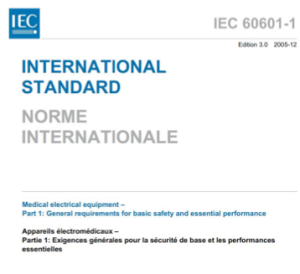Updates on Electrical Safety Standards for Medical Devices-IEC 60601
This blog summarizes updates on electrical safety standards for medical devices for standard IEC 60601.
OSHA finally approved some Nationally Recognized Test Laboratories (NRTL) to AAMI ES 60601-1 (equivalent to IEC 60601-1 edition 3.1 or 3rd ed + A1). Leo Eisner posted a blog summarizing this change (http://bit.ly/OHSA-NRTL-Approval-Update) on January 7, 2015. The blog identifies which labs can issue NRTL Marks and which test labs have OSHA approval in progress. UL 60601-1 is still an approved standard that an approved NRTL can issue an NRTL test mark to, but a few of the NRTLs are now authorized to issue an NRTL Mark to AAMI ES 60601-1 3rd edition + Amendment 1.
The best place to confirm if a Safety Test Lab is an approved NRTL for your medical device is by confirming the notifications published in the U.S. Federal Register. You can also visit the OSHA NRTL website (https://www.osha.gov/nationally-recognized-testing-laboratory-program), but the OSHA website is updated less frequently. Eventually, UL will formally announce the withdrawal of UL 60601-1, and OSHA will take steps to withdraw that Standard from their list of Approved Standards.
On January 14, 2015, Leo Eisner posted a second blog (https://eisnersafety.com/2015/01/14/pre-release-of-iec-60601-2-52-1st-ed-amendment-1-medical-beds/#.VOzViE33-iw) on the topic of IEC 60601-2-52 Medical beds as a pre-release. He discusses the actual changes between the 1st edition and 1st edition + A1. This version is the pre-release before the updated Standard is issued as an International Standard (IS), and it is currently available as a Final Draft International Standard (FDIS). IEC website (http://bit.ly/buy-IEC60601-2-52-amd1-ed1) states: “By purchasing this FDIS now, you will automatically receive, also, the final publication.” The voting period ended on February 13, 2015, and the FDIS should be published shortly after (forecasted to be published on March 27, 2015).
Leo’s blog summarizes each of the changes to the Standard. Among the changes, there is a specific requirement to include hazards related to patients taller than 185 cm (like me). These hazards should be included in the risk management file. The new symbols required to identify the requirements for an “adult” are below:
I find this new symbology particularly interesting because there are many medical devices where users frequently select the incorrect size for the patient. Consistent internationally recognized symbology for weight and height would be helpful for these devices, and bariatric specialty devices could benefit from the use of the last symbol.
If you need additional support for any of the IEC 60601 series of standards, please contact Rob Packard by email or phone (+1.802.281.4381) to discuss your specific needs.
Updates on Electrical Safety Standards for Medical Devices-IEC 60601 Read More »







